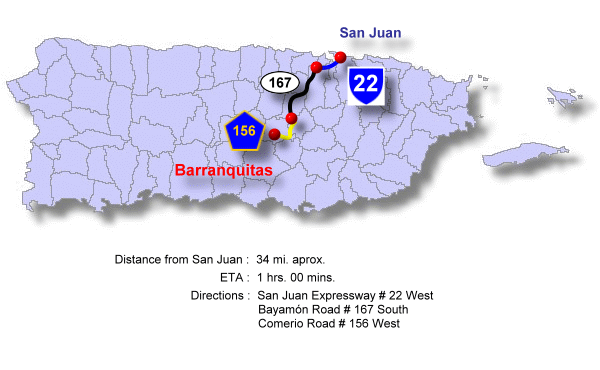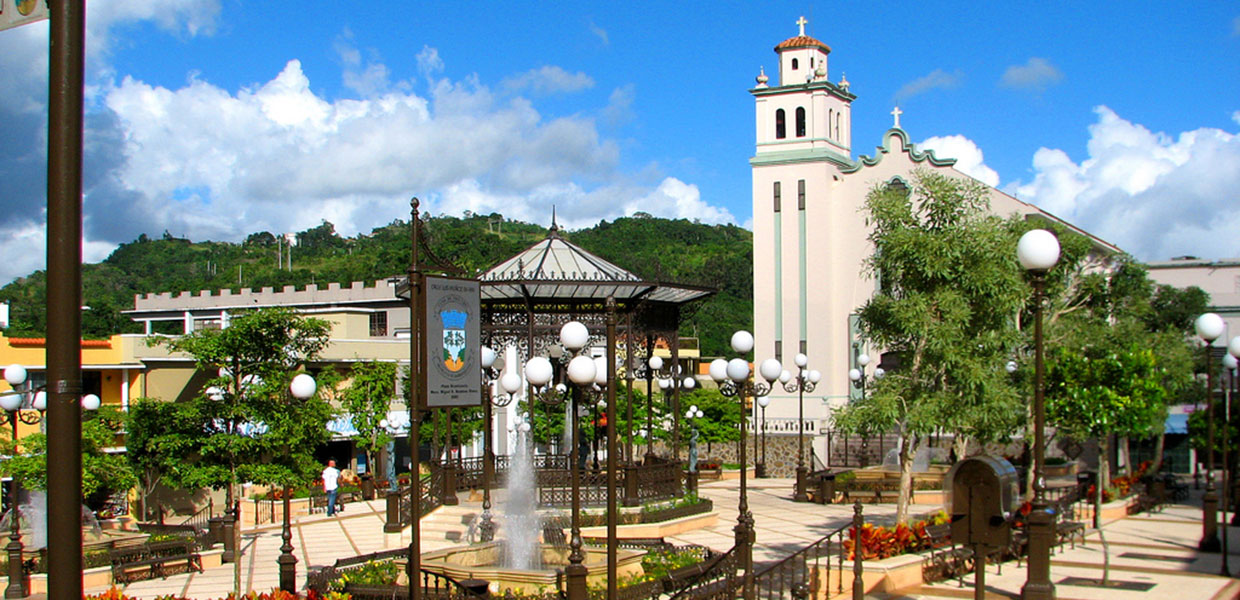
Barranquitas, Puerto Rico
Home of Notable Citizens
 Barranquitas (bahr-rahn-KEE-tahs) is known as “the birthplace of founding fathers,” “the birthplace of craft fairs,” “the altar of the Nation,” and “Luis Muñoz Rivera’s town.” The name of the town comes from the clayey ditches cut into the earth by running water, gullies that are called barrancas, the diminutive of which is barranquitas.
Barranquitas (bahr-rahn-KEE-tahs) is known as “the birthplace of founding fathers,” “the birthplace of craft fairs,” “the altar of the Nation,” and “Luis Muñoz Rivera’s town.” The name of the town comes from the clayey ditches cut into the earth by running water, gullies that are called barrancas, the diminutive of which is barranquitas.
The patron saint is Saint Anthony of Padua, whose feast is celebrated on June 13. Another important festival is the crafts fair, for Barranquitas is an important crafts center, particularly for religious carvings, utensils, and musical instruments.
Barranquitas is located in the eastern humid mountain region of the Central Mountain range. It is bordered on the north by Corozal and Naranjito, on the south by Coamo and Aibonito, on the east by Comerío and Cidra, and on the west by Orocovis. The topography is mountainous and steep.
The economy is based on coffee, tobacco, fruit, and ornamental plants. The town also has some clothing and shoe manufacturing. The climate is very attractive for tourism.
Foundation:
In the early 19th century there was no defined geographical location for the place that we know today as Barranquitas. Documents show that there were 30 settlers in the hills of Barranquitas, which belonged to the somewhat distant town of Coamo. It was due to this distance that the settlers wanted to have their own separate town and parish so that they could avoid the difficult hike to the neighboring churches for Catholic services.
Barranquitas only had a hermitage where there was no regular Mass, only special celebrations. Thus, Barranquitas was founded, as were many other municipalities, largely for religious reasons. This was the reason that in 1803, 72 residents petitioned the government for the founding of a new town. A year later, the petition was granted and, the town of Barranquitas was founded. By 1825 the municipality was fairly large, comprising Pueblo, Helechal, Palo Hincado, Barrancas, Quebradillas, Quebrada Grande, Honduras, Río Hondo, Comerío Alto, Comerío Bajo, and Orocovis wards.

That same year Orocovis ward separated from Barranquitas to join Barros ward from the municipality of Morovis to create the new town of Barros (now Orocovis). Comerío Alto, Comerío Bajo, and Río Hondo wards also separated a year later and joined up with Cidra and Bayamón wards to create the new partido or county of Sabana del Palmar (now Comerío). During the 19th century Helechal, Palo Hincado, Honduras, Quebrada Grande, Quebradillas, Barrancas, and Pueblo wards, as well as a new ward, Cañabón, probably a subdivision of Barrancas are shown belonging to the municipality. The town center had two streets with wooden houses, some of which had gardens.
In 1894, the economy was largely based on the harvests of 84 coffee farms, 52 produce farms, and 3 sugarcane plantations. Guano was mined to be used as fertilizer and there was some tobacco and produce farming.
In 1902, pursuant to a law enacted by the Puerto Rico Legislature to consolidate some of the municipalities, Barranquitas was consolidated with the municipality of Barros (Orocovis). Two years later, under new legislation, Barranquitas regained its status as a municipality.
During the first years of the XVI century (1508), it was necessary to unite the south of the island with the north with a route crossing the center of the island. At the beginning it was very difficult because only the trails used by the Taino Indians were available to make the trip. When the town of Coamo was founded, 32 kilometers from the southern coast, travel was made easier and finally the route made its way from Coamo through Barranquitas and Comerio to Bayamón at the northern coast. Due to the distance of the route, the Spanairds established a place to eat, rest and protect themselves against the inclemencies of the weather in what is known today as Barranquitas.
Location:
 Barranquitas is located in the Central Mountain range of the Island. It borders north with Corozal and Naranjito, south with Coamo and Aibonito, west with Orocovis and east with Comerio.
Barranquitas is located in the Central Mountain range of the Island. It borders north with Corozal and Naranjito, south with Coamo and Aibonito, west with Orocovis and east with Comerio.
Area:
88.4 sq km / 34 sq mi
Population:
28,909 (census 2000)
Population Density:
327.0 per sq km / 850.2 per sq mi
People are known as:
Barranquiteños
Barranquitas is also known as:
Cuna de Próceres (Home of Notable Citizens)
Cuna Feria de Artesanías (Home of Crafts)
El Altar de la Patria (The Altar of the Mother Country)
El Pueblo de Luis Muñoz Rivera (Luis Muñoz Rivera’s Town)
Wards: Barranquitas, Puerto Rico
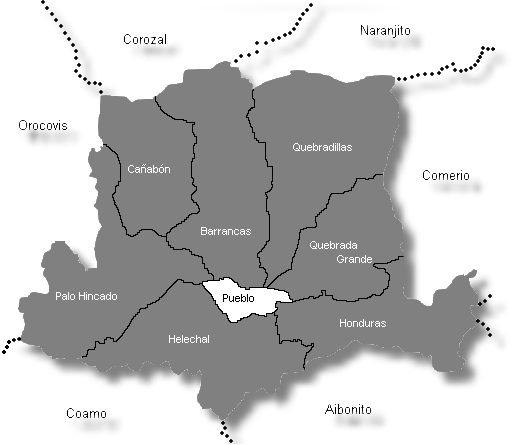
| Census 2000: Population by Wards – Barranquitas | Habitants |
| Barrancas | 5,083 |
| Barranquitas Pueblo | 2,910 |
| Cañabón | 2,221 |
| Helechal | 3,959 |
| Honduras | 2,155 |
| Palo Hincado | 3,963 |
| Quebrada Grande | 3,194 |
| Quebradillas | 5,424 |
| Total | 28,909 |
Source: US Censo 2000
Patron:
San Antonio de Padua
Apartado 1099
Barranquitas, P.R. 00794
Tel. (787) 857-3585
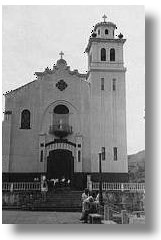
Topography:
Mainly mountainous because of its location in the Central Mountain range. The Torrecilla hill (943 meters), Farallón (788 meters) hill and the San Cristóbal gorge form part of the topography.
Hydrography:
Piñonas, Usabón, La Plata and Grande de Manatí rivers.
Economy:
Agriculture (coffee, fruits, vegetables and flowers), manufacture (footwear and clothing), tourism and commerce.
Average Salary:
$261.64 weekly (1998)
Flag:
 Three horizontal stripes of equal width form the flag of Barranquitas:
Three horizontal stripes of equal width form the flag of Barranquitas:
- white superior (in representation of the silver color on the shield)
- green center
- yellow bottom (in representation of the gold color)
Coat Of Arms:
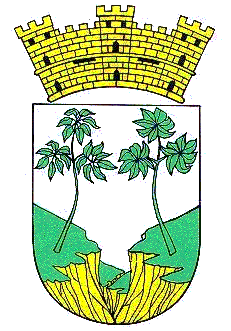 The gorges resemble the San Cristóbal Gorge, located in the territorial division of the municipalities of Barranquitas and Aibonito. The yagrumo trees characteristic of the mountainous zone of Puerto Rico, symbolize the elevation above sea level of Barranquitas, one of the highest elevations within the municipalities of the island. The three tower crown represents cities, towns or municipalities.
The gorges resemble the San Cristóbal Gorge, located in the territorial division of the municipalities of Barranquitas and Aibonito. The yagrumo trees characteristic of the mountainous zone of Puerto Rico, symbolize the elevation above sea level of Barranquitas, one of the highest elevations within the municipalities of the island. The three tower crown represents cities, towns or municipalities.
Places To Visit:
- La Ceiba Recreational Area
- Batey Palo Hincado
- Camp Morton
- Las Bocas Canyon
- Joaquín Rojas Residence Museum
- Luis Muñoz Rivera Birthplace
- Castillo El Cortijo
- Luis Muñoz Rivera Cultural Center
- Sports Complex
- Mausoleum of the Muñoz Family
- Mi Taller Artisanal crafts shop
- Niaian Guest House
- San Cristóbal Canyon Natural Reserve
Events:
- Celeriac Festival – April/May
- Patron Saint”s festival – June
- National Crafts Fair of Barranquitas – July
- Viva Mi Calle Festival – November
- Lighting of Christimas Tree – December
Distinguished Citizens:
- Francisco Aponte Pérez – Attorney and political figure. Aponte Pérez was President of the Bar Association in 1971 and senator-at-large between 1981 and 1988.
- Luis de Casenave – Photographer and journalist. Casenave was one of the most renowned Puerto Rican photographers and worked at newspapers such as El Imparcial and El Mundo.
- Ramón A. Cruz – Educator. Cruz initially taught at the school in his home town, but soon rose until he became the Undersecretary of the Department of Public Education in 1973. Later he became secretary of the department until 1976. Cruz was President of Inter American University between 1978 and 1988.
- Luis Muñoz Rivera – poet, journalist, and political figure. Muñoz published his first poems in Manuel Fernández Juncos’ newspaper El buscapié. He was the founder and leader of the Puerto Rican Autonomist Party and founded the newspaper La Democracia, which he used to campaign against oppression and injustice. He signed the so-called Sagasta Pact with Práxedes Mateo Sagasta, the leader of the Spanish Liberal Party and Prime Minister, which led to the Charter of Autonomy in 1897. Under the short-lived autonomous government of Puerto Rico he was Secretary of Justice and the Interior. He was also one of the founders of the Federal Party (1900) and the Unionist Party (1903). In 1910, he became Resident Commissioner in Washington, DC. He also founded the newspapers El Territorio (1899), El Diario de Puerto Rico (1900), and The Puerto Rico Herald (1901).

- José Muñoz Rivera – poet, journalist, and Secretary of the Puerto Rico Senate (1933 – 1940). Muñoz published some of his writings in the newspapers La Democracia, Puerto Rico Ilustrado, and El Mundo. His early poetry was socially oriented, while he later adopted a modernist aesthetic. His best know poems are “Madre Tierra,” “Oh, montaña,” “El canto de la esperanza,”Sol de gloria,” “El vaso de la vida,” and “Perlas y gloria.”
- Angela Negrón Muñoz – essayist, journalist, and one of the most active feminists on the Island. Her father was the journalist Quintín Negrón Sanjurjo. Negrón Muñoz was active and wrote articles for the newspapers Puerto Rico Ilustrado, El Porvenir, La Democracia, El Día and El Mundo. In 1935 she published a book of women”s biographies, Biografías de mujeres. In 1944, she was awarded a journalism prize by the Instituto de Literatura Puertorriqueña for her article “La tragedia que vive en las entrañas de San Juan.” She founded a magazine, El Idearium, which carried articles on the arts, science, and letters. As a feminist she fought for women’s and children’s rights. Negrón Muñoz organized the Society for the Defense and Welfare of Children as well as the Women’s Temperance League.
- Mercedes Negrón Muñoz – journalist and poet, better known as Clara Lair. Negrón Muñoz was a daughter of the renowned poet Quintín Negrón and a niece of Luis Muñoz Rivera. Lair wrote about love, life, and death. Her work won many awards from the Institute of Puerto Rican Culture. Her prose was recognized by the Instituto de Literatura Puertorriqueña. In 1996, the Puerto Rican filmmaker Ivonne Belén made a film about her life, A Passion named Clara Lair.
- José A. Negrón Sanjurjo – poet and journalist. Negrón Sanjurjo taught school in Caguas and Comerío, among other towns. He published his first work in the weekly El Buscapié, directed by Manuel Fernández Juncos and co-founded El Palenque de la Juventud in 1886. His first political satire in verse was published in the newspaper La Democracia under the penname of “Heráclito”. Negrón Sanjurjo’s work was published in three volumes Mensajeros (1899), Versos postales (1903), Poesías (1905). He also was a bank manager at the Banco Crédito y Ahorro Ponceño.
- Quintín Negrón Sanjurjo – attorney, poet and journalist. Negrón Sanjurjo published his first poems in the newspaper El buscapié directed by Manuel Fernández Juncos. In 1895, he moved to Ponce, where he became a renowned political journalist. Negrón Sanjurjo’s daughter was the poet Clara Lair. Emotion, the landscape, and love are present in his poetry.
- Luis Villaronga – teacher, attorney, journalist, essayist, and novelist. Author of the novel Banderas rojas (1933), among others, and many essays.
Public Schools sorted by educational levels.
Morovis Region
Barranquitas District
| Name | Level | Telephone | Address |
| Elementary | |||
| CAÑABÓN ABAJO | K-6 | (787) 857-0982 | PO Box 627, P.R. 00794-0000 |
| EL FARALLÓN | K-6 | (787) 857-2435 | PO Box 659, P.R. 00794-0000 |
| EL PORTÓN | PK-6 | (787) 857-3686 | PO Box 659, P.R. 00794-0000 |
| LA TORRE | K-4 | (787) 857-3571 | PO Box 69, P.R. 00794-0000 |
| LA VEGA (STEPHEN S. HUSE) | K-6 | (787) 857-0125 | PO Box 6112, P.R. 00794-0000 |
| MANA ABAJO | K-4 | (787) 857-3581 | PO Box 69, P.R. 00794-0000 |
| PETROAMERICA PAGAN | K-6 | (787) 857-6050 | PO Box 2000, P.R. 00794-0000 |
| SINFOROSO APONTE | K-6 | (787) 857-4972 | PO Box 69, P.R. 00794-0000 |
| Intermediate | |||
| JOSÉ BERRIOS BERDECÍA | 7-9 | (787) 857-2305 | PO Box 757, P.R. 00794-0000 |
| PEDRO LABOY | 7-9 | (787) 857-2845 | PO Box 327, P.R. 00794-0000 |
| Secondary | |||
| FEDERICO DEGETAU | K-9 | (787) 857-0646 | PO Box 956, P.R. 00794-1999 |
| SU HELECHAL | K-9 | (787) 857-2360 | PO Box 2000, P.R. 00794-2000 |
| SU LA LOMA (ANTONIO VÁZQUEZ RAMOS) | K-9 | (787) 857-3611 | PO Box 1999, P.R. 00794-0000 |
| SU LAJITAS (RAMÓN T. RIVERA) | K-9 | (787) 857-5571 | PO Box 40, P.R. 00794-0000 |
| High School | |||
| LUIS MUÑOZ MARÍN | 10-12 | (787) 857-3714 | PO Box 899, P.R. 00794-0000 |
| PABLO COLON BERDECÍA | 10-12 | (787) 857-2897 | PO Box 69, P.R. 00794-0000 |
Hymn:
Aquí en el centro de nuestra tierra,
entre montañas de gran verdor,
sonríe glorioso mi Barranquitas,
el pueblecito de mi pasión.
Perla brillante del Torrecilla,
de ambiente plácido, acogedor;
mi Barranquitas, cuna de ilustres,
muy gloria tuya, fue Muñoz.
Adjuntas eres mi amor.
En tus mujeres florece la dulzura
y la ternura de madre angelical;
Flores de otoño, jazmines y claveles;
de todo el año amor primaveral.
Tu fieles hijos, hombres vehementes.
Hombres valientes de corazón
Que tus entrañas brotó contigo.
Por darte orgullo y bella inspiración
bendito seas sagrado suelo
bendito seas nido de amor.
Rizadas joya de verde aliento,
y mil recuerdos…
Adjuntas eres mi amor.

